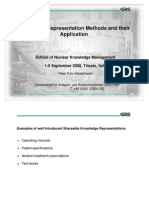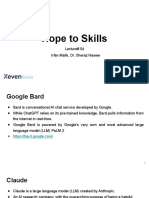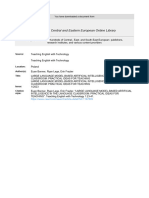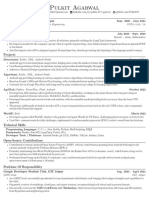0 ratings0% found this document useful (0 votes)
12 viewsKnowledge Graphs v Vector Databases and when not to use them!
The document compares traditional vector databases with knowledge graphs for AI applications, highlighting the limitations of vector databases in handling complex knowledge structures. Knowledge graphs offer a structured approach that mirrors human cognition, enabling better contextual understanding and reasoning, but they can be resource-intensive and impractical for simpler applications. The document also discusses automated knowledge graph creation using LLMs and the benefits of multi-agent systems for knowledge graph enrichment.
Uploaded by
dollieyCopyright
© © All Rights Reserved
Available Formats
Download as PDF, TXT or read online on Scribd
0 ratings0% found this document useful (0 votes)
12 viewsKnowledge Graphs v Vector Databases and when not to use them!
The document compares traditional vector databases with knowledge graphs for AI applications, highlighting the limitations of vector databases in handling complex knowledge structures. Knowledge graphs offer a structured approach that mirrors human cognition, enabling better contextual understanding and reasoning, but they can be resource-intensive and impractical for simpler applications. The document also discusses automated knowledge graph creation using LLMs and the benefits of multi-agent systems for knowledge graph enrichment.
Uploaded by
dollieyCopyright
© © All Rights Reserved
Available Formats
Download as PDF, TXT or read online on Scribd
You are on page 1/ 3
Knowledge Graphs vs.
Vector Databases
for AI and when not to use them.
Executive summary
Traditional Retrieval Augmented Generation (RAG) systems relying on vector databases
have become popular for enhancing AI capabilities, but they face significant limitations when
dealing with complex knowledge structures. While vector databases excel at finding similar
content through semantic search, they struggle to capture the interconnected nature of
information and often miss crucial relationships between concepts. Knowledge graphs offer
a compelling alternative by organizing data as entities and relationships in a structure that
more closely resembles human cognition, enabling AI systems to traverse information paths
more effectively and develop contextual understanding that goes beyond simple similarity
matching. However, despite their advantages, knowledge graphs aren't always the right
solution - following the fundamental engineering principle of "Keep It Simple, Stupid" (KISS),
these complex systems require significant resources to design, implement, and maintain,
making them potentially impractical for straightforward applications where the added
complexity and cost outweighs the benefits.
Key Limitations of Traditional RAG Systems
● Traditional Retrieval Augmented Generation (RAG) systems using vector databases
struggle with complex knowledge bases
● They often miss connections between similar data and broader themes across
information
● The flat structure of vector databases limits contextual understanding
Knowledge Graphs as a Superior Alternative
● Knowledge graphs offer structured, hierarchical information organization
● They mirror human cognition by representing data as entities and relationships
● Knowledge graphs enable more effective traversal of information paths
Fundamental Components of Knowledge Graphs
● Entities: Distinct objects, people, places, events, or concepts (nodes)
● Relationships: Connections between entities (edges)
● Communities: Clusters of related entities creating hierarchical granularity
GraphRAG: Automated Knowledge Graph Creation
● Large Language Models (LLMs) can automate the resource-intensive process of
building knowledge graphs
● GraphRAG (Microsoft tool) workflow:
1. Text is chunked into smaller segments
2. Entities and relationships are extracted using LLMs
3. Subgraphs are merged and summarized
4. Embeddings are created for nodes
5. Community detection algorithms group related entities
6. Community reports are generated and embedded for retrieval
Advanced Querying Techniques
● Local Search: Uses semantic search to find relevant entities, traverses the graph,
and combines connected information
● Global Search: Uses embedded community reports to answer broad thematic
questions (an area where traditional RAG struggles)
● Drift Search: Combines global and local search, using hypothetical document
embeddings to start with broad context before refining
Benefits for AI Agents
● Knowledge graphs provide AI agents with memory and ability to update information
over time
● They facilitate fact extraction and knowledge updating, crucial for maintaining
relevance
● As quoted: A knowledge graph "is the difference between a dumb AI agent and one
that blows everyone's mind"
Multi-Agent Systems for Knowledge Graph Enrichment
● Updating knowledge graphs with new information is complex
● Multi-agent systems with specialized agents for subtasks improve efficiency:
○ Document retrieval agents
○ Summarization agents
○ Entity extraction agents
○ Conflict resolution agents
○ Evaluation agents to assess knowledge quality
● These agents can be retrained periodically to adapt to new information
RAG vs. GraphRAG Comparison
● RAG treats everything as flat text chunks
● GraphRAG maintains structured relationships
● GraphRAG preserves context better
● GraphRAG enables multi-hop reasoning
● GraphRAG produces more complete answers
In summary, while vector databases have their place, knowledge graphs represent a
significant advancement for AI applications requiring complex reasoning, contextual
understanding, and the ability to update knowledge over time.
Why would you not use Knowledge Graphs?
● First rule of building systems, KISS. Keep it simple stupid. Complex systems are hard
to design, slow to build and easy to break.
● Knowledge graphs are expensive to build, sometimes thousands of API calls to LLMs
to construct and computationally intensive during retrieval.
● Storing and scaling knowledge graph setups is challenging.
● Defining schemas and structures for knowledge graphs may require domain expertise.
You might also like
- KAG Graph + Multimodal RAG + LLM Agents = Powerful AI Reasoning _ by Gao Dalie (高達烈) _ in Towards AI - FreediumNo ratings yetKAG Graph + Multimodal RAG + LLM Agents = Powerful AI Reasoning _ by Gao Dalie (高達烈) _ in Towards AI - Freedium13 pages
- GraphRAG + GPT-4o Mini - Building An AI Knowledge Graph at Low Cost - by Shuyi Wang - Jul, 2024 - CubedNo ratings yetGraphRAG + GPT-4o Mini - Building An AI Knowledge Graph at Low Cost - by Shuyi Wang - Jul, 2024 - Cubed31 pages
- A AI: S H M I: Gent Urveying The Orizons of Ultimodal NteractionNo ratings yetA AI: S H M I: Gent Urveying The Orizons of Ultimodal Nteraction80 pages
- 50+ Generative AI Interview Questions - Analytics VidhyaNo ratings yet50+ Generative AI Interview Questions - Analytics Vidhya90 pages
- Advanced RAG Techniques - What They Are & How To Use ThemNo ratings yetAdvanced RAG Techniques - What They Are & How To Use Them16 pages
- LangChain_Academy_-_Introduction_to_LangGraph_-_MotivationNo ratings yetLangChain_Academy_-_Introduction_to_LangGraph_-_Motivation17 pages
- Guide To Evaluating LLM and RAG SystemsNo ratings yetGuide To Evaluating LLM and RAG Systems41 pages
- The Datadog Handbook: A Guide to Monitoring, Metrics, and TracingFrom EverandThe Datadog Handbook: A Guide to Monitoring, Metrics, and TracingNo ratings yet
- Regularization_for_Neural_Networks_1718966083No ratings yetRegularization_for_Neural_Networks_17189660839 pages
- AIM307_Retrieval-Augmented-Generation-with-Amazon-BedrockNo ratings yetAIM307_Retrieval-Augmented-Generation-with-Amazon-Bedrock15 pages
- Top Technical Interview Questions From LeetCode - FAANG and Non FAANGNo ratings yetTop Technical Interview Questions From LeetCode - FAANG and Non FAANG16 pages
- Generative AI With LArge Language ModelsNo ratings yetGenerative AI With LArge Language Models36 pages
- big_data_topic3_[spark]_[thanh_binh_nguyen].TextMarkNo ratings yetbig_data_topic3_[spark]_[thanh_binh_nguyen].TextMark60 pages
- LLMs and Retrieval-Augmented Generation (RAG)No ratings yetLLMs and Retrieval-Augmented Generation (RAG)120 pages
- Analysis_on_Enhancing_Financial_Decision-making_Through_Prompt_EngineeringNo ratings yetAnalysis_on_Enhancing_Financial_Decision-making_Through_Prompt_Engineering5 pages
- Advanced Retrieval-Augmented Generation (RAG) With LangChain, LangGraph, and AI Agents - by Manoj Mukherjee - Oct, 2024 - MediumNo ratings yetAdvanced Retrieval-Augmented Generation (RAG) With LangChain, LangGraph, and AI Agents - by Manoj Mukherjee - Oct, 2024 - Medium15 pages
- 024 KnowledgeRepresentationMethods (Puhr)No ratings yet024 KnowledgeRepresentationMethods (Puhr)18 pages
- Using AI Tools To Lesson Plan - EdutopiaNo ratings yetUsing AI Tools To Lesson Plan - Edutopia21 pages
- A_Questionnaire_Survey_on_AIEducation_CountingNo ratings yetA_Questionnaire_Survey_on_AIEducation_Counting4 pages
- Data Science - A Kaggle Walkthrough - Introduction - 1 PDFNo ratings yetData Science - A Kaggle Walkthrough - Introduction - 1 PDF5 pages
- 7 Agentic RAG System Architectures to Build AI AgentsNo ratings yet7 Agentic RAG System Architectures to Build AI Agents12 pages
- LLM based AI Agents Overview -What, Why, How, PPT PresentationNo ratings yetLLM based AI Agents Overview -What, Why, How, PPT Presentation26 pages
- Hope To Skills: Lecture# 04 Irfan Malik, Dr. Sheraz NaseerNo ratings yetHope To Skills: Lecture# 04 Irfan Malik, Dr. Sheraz Naseer10 pages
- Large-Language-Model-Based-Artificial-Intelligence-In-The-Language-Classroom-Practical-Ideas-For-Teaching - Content File PDFNo ratings yetLarge-Language-Model-Based-Artificial-Intelligence-In-The-Language-Classroom-Practical-Ideas-For-Teaching - Content File PDF20 pages
- Context-Aware Summarization For PDF Documents Using Large Language ModelsNo ratings yetContext-Aware Summarization For PDF Documents Using Large Language Models6 pages
- Langchain Retrieval Augmented Generation White Paper100% (1)Langchain Retrieval Augmented Generation White Paper23 pages
- Download Quick Start Guide to Large Language Models Second Edition Sinan Ozdemir ebook All Chapters PDF100% (6)Download Quick Start Guide to Large Language Models Second Edition Sinan Ozdemir ebook All Chapters PDF81 pages
- GenAI and LLMs Creative Projects, With SolutionsNo ratings yetGenAI and LLMs Creative Projects, With Solutions206 pages
- The Definitive Guide to Data Integration: Unlock the power of data integration to efficiently manage, transform, and analyze dataFrom EverandThe Definitive Guide to Data Integration: Unlock the power of data integration to efficiently manage, transform, and analyze dataNo ratings yet
- Fundamentals of Analytics Engineering: An introduction to building end-to-end analytics solutionsFrom EverandFundamentals of Analytics Engineering: An introduction to building end-to-end analytics solutionsNo ratings yet
- Concepts and Techniques: Mining Sequence Patterns in Transactional DatabasesNo ratings yetConcepts and Techniques: Mining Sequence Patterns in Transactional Databases26 pages
- Data Management API Guide: General Parallel File SystemNo ratings yetData Management API Guide: General Parallel File System76 pages
- Sage X3 - User Guide - REF-Shipping Interface SHPSYS User Setup-V6 PDFNo ratings yetSage X3 - User Guide - REF-Shipping Interface SHPSYS User Setup-V6 PDF13 pages
- Big Data, Big Innovations: Collaborative, Self-Service Analytics Delivers Unprecedented ValueNo ratings yetBig Data, Big Innovations: Collaborative, Self-Service Analytics Delivers Unprecedented Value4 pages
- Installing and Configuring Oracle Apex 5.0No ratings yetInstalling and Configuring Oracle Apex 5.011 pages
- Complete Reference To Informatica - Informatica Experienced Interview Questions - Part4No ratings yetComplete Reference To Informatica - Informatica Experienced Interview Questions - Part43 pages
- Introduction To Digital Forensics: Florian BuchholzNo ratings yetIntroduction To Digital Forensics: Florian Buchholz30 pages

























































































